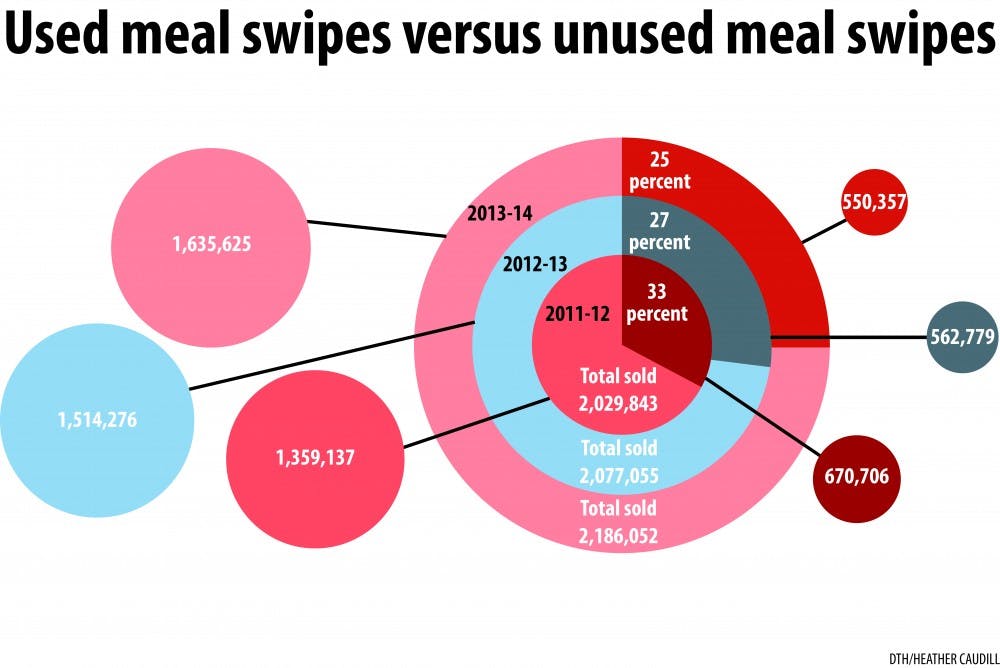Student government has no options to lower the fee unless the total loan amount changes, Best said.
“We really have no recourse — like lowering or eliminating the fee — when it comes to debt fees because the fee is paying off a loan that has already been taken out,” she said.
Senior Mary Elizabeth Entwistle, who has been on the Student Dining Board for two years, said the board reviews the fee every year, but there is little they can do to lower or change it.
The board consists of 10 students and five administrators. It meets weekly to discuss dining services and has supported the fee since the 1990s.
“Without those fees, the campus would not have been able to build the dining facilities we currently have,” said Kyle Reeves, a member-at-large on the Student Dining Board, in an email. “One thing that is important to clarify is that the debt the fee is intended to pay off is not accumulated due to any sort of frivolousness.”
Scott Myers, director of food and vending services, said CDS could be making the debt payments until the 2030s. And that’s without the new Lenoir expansion.
Following the money
In the 2013-14 year, Carolina Dining Services spent $105,000 more than what was budgeted after replacing the air handlers in Lenoir and renovating the Cafe McColl and Tar Heal Cafe.
To get the day's news and headlines in your inbox each morning, sign up for our email newsletters.
Administrators said they keep at least one-year’s mortgage payment in a savings account, but that doesn’t mean being in debt is something Myers and Freeman are content with.
“We do have a little bit of money, but if I had to do a $5 million renovation — no, I cannot do a $5 million renovation,” Freeman said.
For five of the past 10 years, CDS has ended its fiscal year with a deficit, ranging from $100,000 to $2 million.
In 2013-14, almost 30 percent — or more than $11 million — of the CDS budget went toward salaries and employee benefits.
“We need to make a little bit to fund renovations, but the dining halls are not supposed to make a profit,” Fajack said.
Aramark partnership
UNC entrusts all dining operations to Aramark, a conglomerate that provides food services for universities, correctional institutions and healthcare institutions.
The University contract with Aramark is set up as a cost plus two percent plan, meaning UNC pays the company two percent of its revenues for Aramark to operate here.
Aramark runs all UNC dining services, including coffee shops, restaurants, dining halls and even food vendors at athletic events.
Fajack said Aramark has partnerships with national chain restaurants that benefit the school, along with professional training and chefs.
N.C. State University and Appalachian State University dining services providers have taken a different approach. The two universities are the only ones in the UNC-system that run their own dining halls and do not use a company such as Aramark.
Appalachian just completed a $6 million renovation. Meal plan prices didn’t rise to cover the cost, said Heather Brandon, food services specialist at ASU.
Appalachian’s dining service, which currently serve about 5,500 students living in residence halls who are all required to buy a meal plan, also does not operate on a deficit.
Randy Lait, hospitality services senior director at NCSU, said the NCSU dining hall never operated in a deficit until about five years ago when the university decided to take on three major renovation projects.
NCSU’s debt from these renovations totals about $12 million. None of the money to pay back the debt will come from student fees, Lait said.
“A few of our locations needed remodeling, and we needed larger facilities,” he said. “But when we started to move forward on those projects, we weren’t burdened by already existing substantial debt.”
Dealing with the debt
To offset the financial effects of its $36 million debt, Carolina Dining Services pulls its money from its sale of meal plans and the student fee.
Meal plans are priced by how much revenue CDS needs from them, not by how many meals students buy.
“We get hit every couple of years, and so does every single other school about the wasted meals,” Freeman said. “But we, the staff, don’t look at the missed meals. We look at, ‘What do we need to do to run this building?’”
In 2013-14, about 25 percent of meal swipes went unused, down from 33 percent in 2011-12.
Resident district manager Scott Weir said if students were to use all of their meal swipes, then the costs of operating the dining halls would increase because of additional food, labor, supplies and utility needs.
Despite the waste, Weir said overall popularity in meal plans has grown by about 5 percent since the fall 2011 semester. About 6,400 students had a meal plan in fall 2011 and about 6,800 currently have a meal plan.
“We feel like we have enhanced the value and convenience of having a meal plan for the students,” Weir said in an email.
Prices for meals have increased slightly each year in response to annual costs. This year, meal plan prices went up 1.9 percent. During the past two academic years, meal plan prices went up as much as 3 percent.
“We do approve any and all improvements and usually they’re minor things that we can all handle with what CDS makes each year,” Entwistle said. “But with major renovations, such as when they re-did Top of Lenoir, or when they built Rams Head — we can’t do that with just the cash we have on hand.”
special.projects@dailytarheel.com



